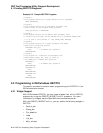
5
DEC Text Processing Utility Program
Development
Previous chapters have described the lexical elements of the DECTPU language,
such as data types, language statements, expressions, built-in procedures,
and so on. This chapter describes how to combine these elements in DECTPU
programs. You can use DECTPU programs to perform editing tasks, to customize
or extend an existing application, or to implement your own application layered
on DECTPU.
Before you start writing programs to customize or extend an existing application,
you should be familiar with the DECTPU source code that creates the editor
or application that you want to change. For example, if you use the Extensible
Versatile Editor (EVE) and you want to change the size of the main window, you
must know and use the procedure name that EVE uses for that window. (If you
want to change the main window, you use the procedure name eve$main_window.
Many of the EVE variables and procedure names begin with eve$.)
The sample procedures and syntax examples in this book use uppercase letters
for items that you can enter exactly as shown. DECTPU reserved words, such as
built-in procedures, keywords, and language statements are shown in uppercase.
Lowercase items in a syntax example or sample procedure indicate that you must
provide an appropriate substitute for that item.
This chapter discusses the following topics:
• Creating DECTPU programs
• Programming in DECwindows DECTPU
• Writing code compatible with DECwindows EVE
• Compiling DECTPU programs
• Executing DECTPU programs
• Using DECTPU startup files
• Debugging DECTPU programs
• Handling Errors
5.1 Creating DECTPU Programs
When you write a DECTPU program, keep the following pointers in mind:
• You can use EVE or some other editor to enter or change the source code of a
program in the DECTPU language.
• A program can be a single executable statement or a collection of executable
statements.
DEC Text Processing Utility Program Development 5–1


















